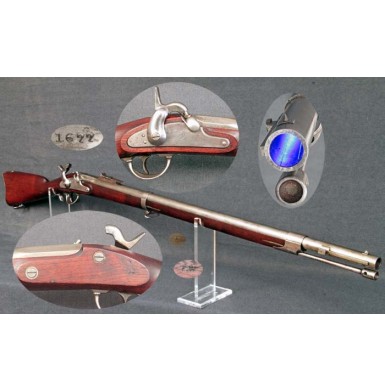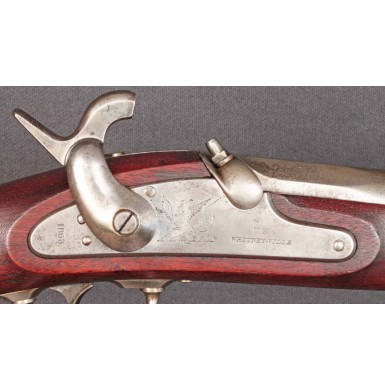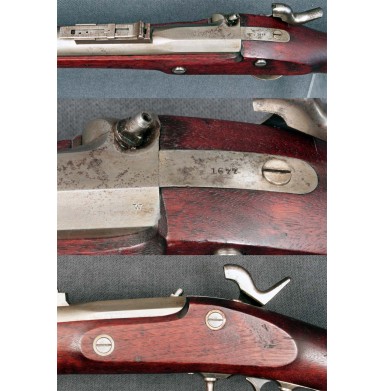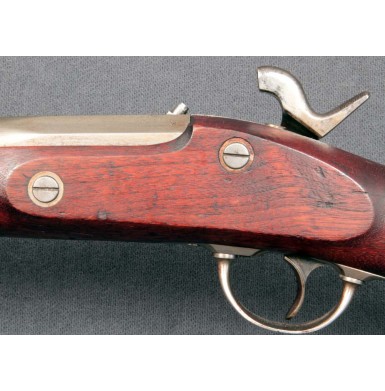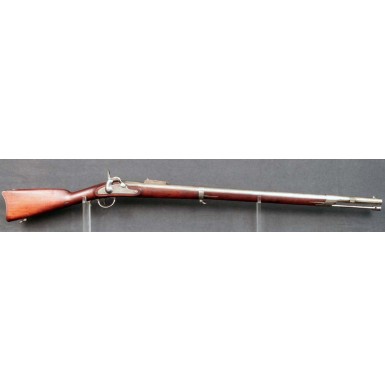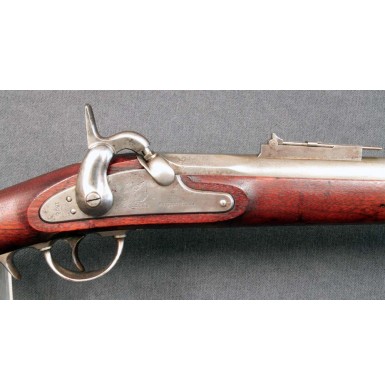M-1861 Naval Rifle by Whitney - Near Excellent
- Product Code: FLA-1889-SOLD
- Availability: Out Of Stock
-
$1.00
This is a VERY FINE+ to NEAR EXCELLENT condition example of the US M-1861 Naval Rifle as produced under contract by the famous Eli Whitney company. These rifles are often referred to as Plymouth Rifles due to the fact that the initial batch of rifles, from which the contract pattern was derived, were tested on board the USS Plymouth from 1856-1858 under the direction of Captain (later Admiral) Dahlgren. The rifle is essentially a copy of the French Carbine-A-Tige and retinas many of the French design features, including a finger spur on the rear of the trigger guard plate, the French pattern adjustable rear sight and the heavy cupped ramrod necessary to exert enough force on a loaded projectile to suitable expand it upon the Tige. Unlike the French musket, which was 18mm (about .708 caliber), the US variant used the more typical .69 caliber bore. While the US Army was headed towards a reduced bore .58 rifle and rifle musket in the late 1850’s, Dahlgren felt it important to retain the large bore for the rifles used on board ships. When the pattern was officially adopted as the US M-1861 Naval Rifle, Whitney was awarded a contract in July of 1861 to deliver 10,000 of them at a price of $25 each, to include a brass handled saber bayonet. A sample “Plymouth Rifle” (one of the original test guns from the 1856-1858 trials) was forwarded to Whitney to use as a guide in production, and Springfield Armory supplied sample locks, butt plates and trigger guards to copy. Whitney obtained permission to use his contract pattern1861 model rifle musket locks that he already had on hand to help complete the contract in a timely fashion. He apparently took other liberties during the production of the rifles, as minor variances in hardware, etc are not uncommon. Ever the penny-pincher, Whitney tried to utilize any parts already on hand to reduce the actual cost incurred to produce the Naval rifles. Unfortunately, Whitney had issues with the initial deliveries of the guns. He had hoped to have the barrels produced by Remington, but that company was too busy with its own government contracts to provide the rifle barrels. Whitney’s initial delivery on the contract was to be 500 guns in early February of 1862, but due to problems obtaining barrels, his deliveries were delayed. The first 2,000 barrels that Whitney obtained from a contractor failed to pass the government proof testing, and Whitney was forced to produce the barrel himself, in house, from cast steel. This caused a substantial delay. Whitney delivered the first five guns under the contract in October of 1862, and they were found to be nearly pounds lighter than the sample “Plymouth Rifle” that had been provided to him to guide the manufacturing of the guns. This weight loss would make the recoil from the rifle rather objectionable, but the exigencies of the situation resulted in the arms being accepted at the lighter weight. The first substantial delivery, of 100 arms, was made in early February of 1863. Some of the first M-1861 Naval Rifles to see service aboard ships were issued to the Nansemond, the William Bacon and the Eutaw, all of which served with the Atlantic Blockading Squadron during 1863. By the end of 1863, Whitney had managed to catch up on his contract, and had delivered 5,300 of the rifles to the Navy. An additional 4,695 rifles had been delivered to the Navy by the end of 1864. When the initial 5 samples delivered in 1862 are included, this brings the total to 10,000 pieces. It has often been suggested that many of these rifles never saw service, however arms historian and author John D McAulay contradicts that claim. In fact, he notes in Civil War Small Arms of the US Navy & Marine Corps that nearly all of the rifles delivered by the summer of 1864 were issued to warships. IN fact in September of 1864, the Boston Naval yard was turning down requests for Plymouth Rifles, as there were none available in stores. In one case, the commander of the Ella, serving with the Potomac Flotilla, requested on June 22, 1864 that he be allowed to turn in his Spencer Rifles due to their poor performance and replace them with Plymouth Rifles! He notes in his request that due to accidental discharges with the Spencer’s two men have been killed and two more wounded. He also notes that not having bayonets for the Spencer’s reduced their effectiveness against boarders “by half”. This is likely one of the very few instances where a commander requested a muzzle loading percussion arm to replace a breechloading metallic cartridge gun!
This particular rifle is likely one of those Whitney arms where some “liberties’ were taken. The rifle has a lock plate that was likely left over from his contract 1861 rifle musket production run, as it has the large Whitney Eagle-Shield-Flag motif forward of the hammer and U.S. / WHITNEY “ VILLE below the bolster. Most of the later 1863 and all of the 1864 dated guns have a different eagle motif on the lock. The date 1863 is stamped vertically behind the hammer. The locks of the rifles were originally color case hardened for strength, and then polished bright. This lock still retains light, faded traces of the original mottled blue-gray case coloring. The number 1677 is stamped on the tang of the barrel. This number served both as a serial number and as the mating number that matched the one found on the brass hilted Collins & Company saber bayonet, which had been hand fit to the gun. I have owned another Whitney Naval rifle in similar condition, serial numbered 14xx, which had an 1862-dated lock. This indicates that the numbering was consecutive, and suggests that this rifle was produced early in 1863. According the McAulay’s book, the rifles appear to have been delivered very close to numerical order, based upon the serial number. The barrel is devoid of the usual proof marks (no VP/Eagle Head or date), but carries the correct inspection mark W for Frank C Warner, who inspected Whitney’s contract Naval rifles. The stock is also marked with his initials, simply a block F.W on the flat, opposite the lock. A clear US is stamped on the tang of the iron butt plate as well.
Overall the rifle is in VERY FINE to NEAR EXCELLENT condition. It is 100% complete, correct and original with no replacement parts or repairs. It retains both of the original sling swivels, as well as the original heavy, cupped ramrod, which is full length and complete with threads. The French style 1000-yard, adjustable ladder rear sight is present and in excellent condition, and the original iron-blade front site and the saber bayonet lug are all present as well. The metal is in very nice condition, retaining much of the original Armory Bright polished finish, which has dulled slightly with age. There is some scattered, lightly oxidized age discoloration present along the barrel, and a few minor patches of pinpricking present as well. Most of the pinprick peppering is confined to the breech area, indicating that the gun was fired at least a few times, and the caustic fulminate of mercury percussion caps caused some very minor flash erosion. The barrel flats are extremely sharp and crisp, as are all markings. The lock is well marked as well, and even the Whitney Eagle motif, which is almost always lightly stamped, is relatively crisp and clear. The lock functions very well on all positions and works perfectly. The .69 caliber bore is absolutely in mint condition, and is quite bright and clean with extremely sharp three-groove rifling. The bore is so fine that I’m sure this is a rifle that would be a tack driver were someone to want to shoot it. The wood on the gun is in about EXCELLENT condition and is extremely crisp. The stock is solid, complete and full length and there no breaks, cracks, repairs or structural issues present. All edges are wonderfully sharp and nearly as fresh as when the gun left the factory. The wood to metal fit is equally outstanding as well. The wood retains a slightly “feathery”, open grain that is really wonderful. The only reason the stock does not rate “mint” is that there are a number of light handling marks and minor dings which indicate handling and use. The most noticeable is a thumb sized bruise on the obverse wrist, behind the lock, which may be where another gun in storage bumped this one with its hammer, or possibly fell against this rifle. The bruise is very old and quite smooth and does not detract from this exceptional rifle at all, but is mentioned for exactness. Even the rammer channel remains crisp and sharp. The wood has an extremely attractive reddish-brown color, which is very appealing visually.
Overall this is a really outstanding example of the Whitney M-1861 Naval rifle. The rifle is 100% complete and correct in all way, and simply has a fantastic look to it. With only 10,000 produced, it is a rifle that is often missing from even advanced Civil War long arms collections. When these guns are found for sale they are often well used, and their life at sea, and storage in Naval facilities in close proximity to the salt air certainly did not help to preserve these arms in high states of condition. This one is just a fantastic looking piece, in equally fantastic shape, and it would be a fantastic addition to any Civil War naval arms or long arms collection. Due to the wonderful condition and eye appeal, it would be a wonderful center piece to a Naval display.
SOLD
